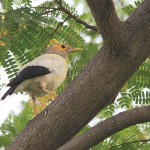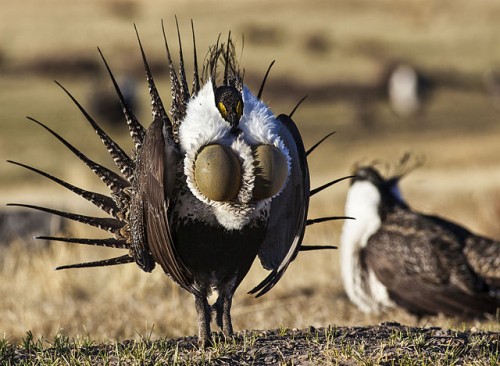
My wife and I are residents of Sonoma County, California. Sonoma County is home to a rugged Pacific coastline, towering redwood forests, and rolling vineyards. It is also located in the heart of the Pacific Flyway, and as a result I am an avid birder. My love for birds gave me reason to reflect on how American commerce has endangered several bird species.
Perhaps the most famous documented case is the Ivory-Billed Woodpecker (Campephilus principalis). The Ivory-Billed Woodpecker is a truly regal bird — the largest member of the North American Woodpecker family. It was thought to be extinct for several decades and its existence remains a controversy. Tim Gallagher and Bobby Harrison rediscovered the bird in 2004. Gallagher reviewed the history of the species and his adventure in the book The Grail Bird. Timber harvesting of old-growth forests in the swamps of the deep south drove the bird to the brink of extinction.
The fight to save the bird came to a climax in the early 1940s. John Baker, president of the National Audubon Society, requested aid from his personal friend, President Franklin D. Roosevelt. President Roosevelt tasked his Secretary of Interior with saving the Ivory-Billed’s stronghold: the Singer Tract. However, the plea from the government and a $200,000 pledge from the governors of Louisiana, Arkansas, Mississippi, and Tennessee was rejected. Singer Sewing Company, owner of the land, had sold the timber rights to Chicago Mill and Lumber Company. Chicago Mill and Lumber did not stop its harvesting activities and Singer refused to try and end the cutting.
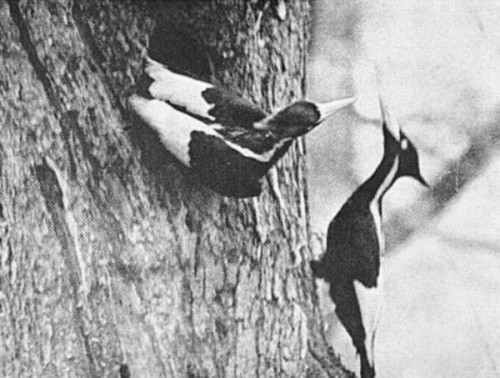
Sightings of the rare Ivory-Billed Woodpecker dwindled to few each decade. In 2004, Gallagher’s Cornell team made its findings public, including a brief, highly disputed film of the bird. The following year, a team of ornithologists from Auburn University reported another glimpse along the forests of Choctawhatchee River. The 21st century findings remain disputed despite the pedigree of the teams. The Ivory-Billed is often found in the “recently extinct” section of most field guides. The king of American woodpeckers is a steep price to pay for timber.
Another environmental disaster in American history is the deforestation of the old-growth redwood forests of the Pacific Northwest. 90% of these forests have been harvested by the timber industry and those that remain are located in federal and state parks. The famous Northern Spotted Owl (Strix occidentalis caurina), which nests in old-growth forests, was listed as threatened under the Endangered Species Act in 1990.
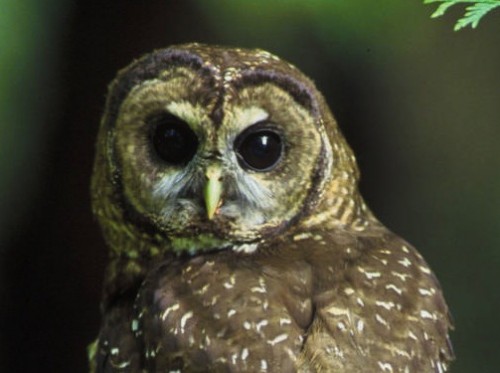
The lesser-known Marbled Murrelet (Brachyramphus marmoratus) received threatened status in 1992. In fact, nesting sites of Marbled Murrelets were a mystery until 1974. A maintenance worker climbing an old-growth tree found a nest in Big Basin State Park near Santa Cruz, California. Both Marbled Murrelets and Northern Spotted Owls require 200-year-old trees for their nests. Logging companies and the American Forest Resources Council continued to push for increased amounts of forest harvesting on federal land. In 1994, President Clinton adopted the Northwest Forest Plan to protect the old-growth forests and its endangered species.
Despite the added protection, the Northern Spotted Owl population has plummeted to less than 5000 in Pacific Northwestern United States and British Columbia, Canada1. The Marbled Murrelet population is estimated to be under 20,000 in the same region 2.
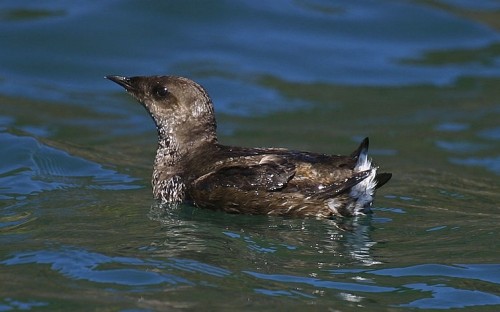
The status of the Northern Spotted Owl will come under review again this year. Timber lobbies will try to get the Northwest Forest Plan scaled back. Lobbyists claim the industry has been allowed less than half the timber haul that was promised. Loggers feel that invasive species such as the Barred Owl are the true threat to the Northern Spotted Owl. Public hearings have begun to debate increased logging in national parks. The American Forest Resources Council wants individual regions to determine the level of cutting and to remove the blanket federal protection. A weak economy and a need to protect jobs in the coming election year will put pressure on conservation legislation.
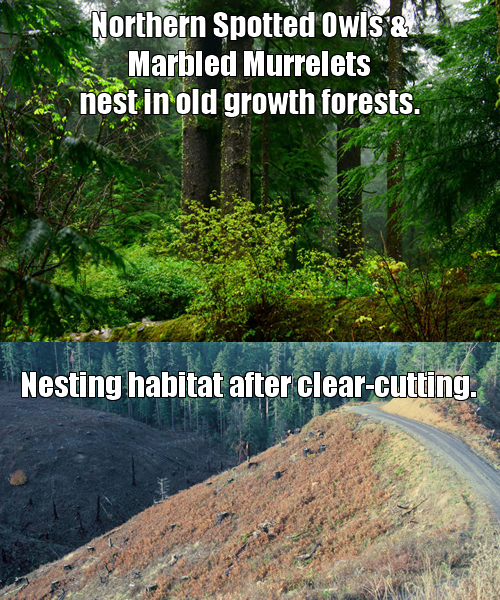
The Greater Sage Grouse (Centrocercus urophasianus) is one of the hottest conservation battles and is well documented in The Sagebrush Sea. On September 30, 2015, a vote will determine if the Sage Grouse is to be protected under the Endangered Species Act.
Sage Grouse numbers have been tough to gauge. Although the population once numbered up to 16 million, it has plummeted to possibly below 200,000; habitat destruction is cited as the culprit3. The male Sage Grouse has an average lifespan of four years and clutches only have a 40% rate of survival. This species requires habitat with a vast, unbroken range of sagebrush. Sage Grouse habitat is fertile land for agriculture, and rich in minerals, oil and natural gas. Livestock grazing and decades of exploitation from mining and drilling have fragmented sagebrush steppes; the Sage Grouse population will be slow to recover.
Watch — and listen! — to the male Sage Grouse “strutting his stuff” for females:
Despite the dramatic plunge in population, the Sage Grouse faces an uphill battle for gaining protection under the ESA. Sage Grouse habitat in the U.S. covers a large range encompassing eleven states. Heavily-funded opposition includes the United States Military, United States Congressmen and Senators, and lobbyists representing agriculture, cattle ranchers, oil and gas exploration, and mining interests. Opponents to the Sage Grouse listing will cite the economic hardship caused across several industries and a threat in reduction of U.S. military facilities.
Western governors and members of Congress have resisted an Endangered Species Act (ESA) listing because of the stringent federal requirements that come along with it.
Several states and the Department of Interior banded together this year to come up with a management plan that could go toward preventing a listing.
The issue has cropped up in defense debates because the grouse’s territory includes lands managed by the Pentagon. The House version of this year’s National Defense Authorization Act seeks to block a Fish and Wildlife Service listing decision for the bird, with lawmakers arguing it could disrupt operations on military installations.
The opposition will also cite a recent report from the United States Department of Agriculture that reflects recent regional increases in population4, even though conservation programs take many years to determine success. Sage Grouse protection opponents will state that with regional success, there is no need for federal protection.
The United States has a long history of allowing its economic interests hinder its wildlife conservation efforts. The controversy continues on several fronts. American businesses fear blanket protections from the Endangered Species Act. American industries use times of economic hardship to weaken and oppose wildlife conservation. The United States recovery from the Great Recession has been slow and is now at a critical point. As a result, protections for the Northern Spotted Owl, Marbled Murrelet, and Sage Grouse are under immense pressure. Stay tuned.
1. Northern Spotted Owl: Basic Facts
2. Marbled Murrelet Population
3. The Sagebrush Sea
4. Greater Sage Grouse Population on the Rise

